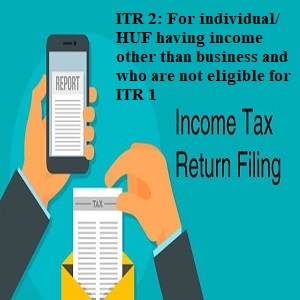Now file ITR 2 on e-filing website for FY 2021-22 i.e. AY 2022-23 | File ITR with experts on Taxontips

Income Tax return for FY 2021-22 were announced, however till date only ITR 1 and 4 were available for filing. Now ITR 2 is also available for filing on e filing website.
So, let’s have a look on what are some important amendments in ITR 2 and who are eligible to file the same.
First of all ITR 2 is the biggest and exhaustive return as far as Individual and HUF is concerned where Individual and HUF is not earning income from business and ITR 2 is also the first and basic return for non resident individual to file in India.
Let’s first see who are eligible to file ITR 2 Form:
This Return Form is to be used by an individual or a Hindu Undivided Family (HUF) who is not eligible to file Form ITR‐1 (Sahaj) and who is not having any income under the head “Profits or gains of business or profession”
This Return Form should not be used by an individual whose total income for the Assessment Year 2022‐23 includes Income under the head “Profits or Gains of Business or Profession”.
1. Change in Schedule FA:
Schedule FA deals with disclosure of foreign assets by a person who is a ordinary resident in India. Till now while declaring foreign assets in this schedule assessee was free to declare foreign assets held by him as on end of relevant accounting period of foreign jurisdiction.
Now no separate accounting periods shall be followed, CBDT had mandated all the taxpayers to report the foreign assets held by them as on 31st December. Thus, while filing Income Tax return for AY 2022-23, assessee has to disclose foreign assets held between 01.01.2021 to 31.12.2021.
2. Separate disclosure of Interest of contribution to EPF above Rs. 2.5 lakh:
Finance Act, 2021 had introduced a provision under section 10(11) and 10(12) wherein it was mentioned that if the contribution recognised and statutory provident fund by the employee is above Rs. 2.5 lakh in a year then the interest on that excess contribution will be taxable.
However, if the amount of employer does not make contribution then the threshold limit mentioned above will be increased to Rs. 5,00,000.
To read more on such taxability CLICK HERE: 2 Major amendments in Budget 2021 which would affect HNI – High net worth individuals – Taxontips
3. Limiting the rate of surcharge on dividend income:
After Finance Act, 2020 dividend was made taxable in the hands of recipient at applicable tax rates. However, the rate of surcharge on such dividend was restricted to 15% if income exceeds as in case of capital gain.
Thus, in case of Individual, HUF, AOP, BOI, the surcharge on tax on dividend income shall be levied at the rate of 10% if it exceeds Rs. 50 lakh but does not exceed Rs. 1 crore and at the rate of 15% when it exceeds Rs. 1 crore.
The consequential changes have been made in Schedule Part B – TTI (Computation of tax liability on total income) to limit the rate of surcharge on dividend income taxable under Section 115AD and other dividend income.
Disclaimer: The views presented in the above article are personal views of our team and has no legal binding. For any legal opinion consult a tax professional.
You can book phone consultation/ assistance online with expert as mentioned below:
To book ITR filing with experts CLICK ME.
To book phone consultation with experts for any Income tax related matters CLICK ME.
To book consultation for Faceless Assessment with experts CLICK ME.
To book phone consultation with experts for GST related matters CLICK ME.
To book general phone consultation with expert CLICK ME.